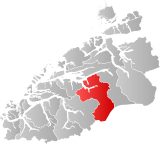Rauma Municipality
Rauma kommune | |
|---|---|
 View of Åndalsnes in Rauma | |
 Møre og Romsdal within Norway | |
 Rauma within Møre og Romsdal | |
| Coordinates: 62°30′17″N 07°46′55″E / 62.50472°N 7.78194°E | |
| Country | Norway |
| County | Møre og Romsdal |
| District | Romsdal |
| Established | 1 Jan 1964 |
| • Preceded by | Eid, Grytten, Hen, Voll, & Veøy municipalities |
| Administrative centre | Åndalsnes |
| Government | |
| • Mayor (2019) | Yvonne Wold (SV) |
| Area | |
• Total | 1,449.26 km2 (559.56 sq mi) |
| • Land | 1,389.96 km2 (536.67 sq mi) |
| • Water | 59.30 km2 (22.90 sq mi) 4.1% |
| • Rank | #61 in Norway |
| Population (2023) | |
• Total | 7,046 |
| • Rank | #143 in Norway |
| • Density | 5.1/km2 (13/sq mi) |
| • Change (10 years) | |
| Demonym | Raumaværing[1] |
| Official language | |
| • Norwegian form | Neutral |
| Time zone | UTC+01:00 (CET) |
| • Summer (DST) | UTC+02:00 (CEST) |
| ISO 3166 code | NO-1539[3] |
| Website | Official website |
Rauma is a municipality in Møre og Romsdal county, Norway. It is part of the traditional district of Romsdal. The administrative centre is the town of Åndalsnes. Other settlements in Rauma include the villages of Måndalen, Innfjorden, Veblungsnes, Verma, Isfjorden, Eidsbygda, Rødven, Åfarnes, and Mittet. Most settlement in the municipality is located along the fjords and in the Romsdalen valley.
The municipality surrounds part of the southern end of Romsdalsfjorden and the Isfjorden and it also includes the Romsdalen valley and Romsdalsalpene mountains. In the lower part of the valleys and around Romsdal Fjord and Rødvenfjorden are driven agriculture with emphasis on livestock. The clothing industry has traditionally been a dominant industry in the municipality, especially in Isfjorden. In the summer, Rauma has a fairly large amount of tourist traffic. The top tourist attractions include mountain climbing/hiking, salmon fishing, Trollstigen, and the historic Rødven Stave Church.[4]
The 1,449-square-kilometre (559 sq mi) municipality is the 61st largest by area out of the 356 municipalities in Norway. Rauma is the 143rd most populous municipality in Norway with a population of 7,046. The municipality's population density is 5.1 inhabitants per square kilometre (13/sq mi) and its population has decreased by 5.1% over the previous 10-year period.[5][6]
- ^ "Navn på steder og personer: Innbyggjarnamn" (in Norwegian). Språkrådet.
- ^ "Forskrift om målvedtak i kommunar og fylkeskommunar" (in Norwegian). Lovdata.no.
- ^ Bolstad, Erik; Thorsnæs, Geir, eds. (26 January 2023). "Kommunenummer". Store norske leksikon (in Norwegian). Kunnskapsforlaget.
- ^ Store norske leksikon. "Rauma" (in Norwegian). Retrieved 2 June 2013.
- ^ Statistisk sentralbyrå. "Table: 06913: Population 1 January and population changes during the calendar year (M)" (in Norwegian).
- ^ Statistisk sentralbyrå. "09280: Area of land and fresh water (km²) (M)" (in Norwegian).

